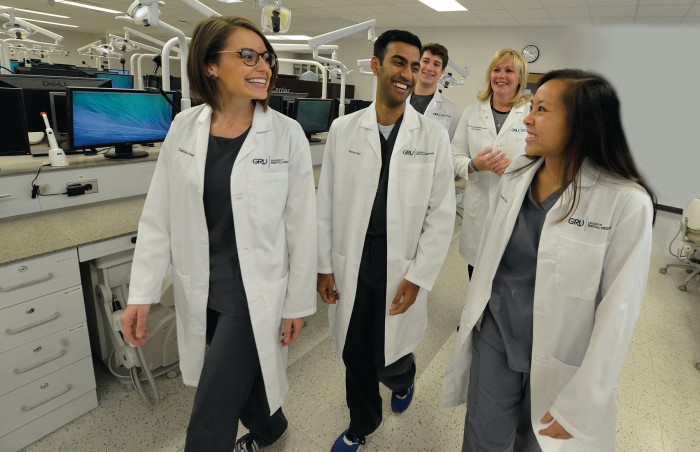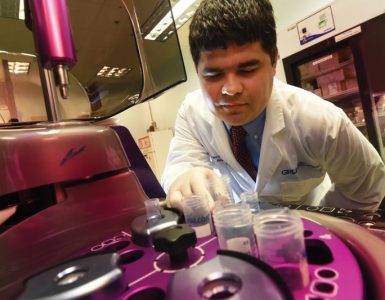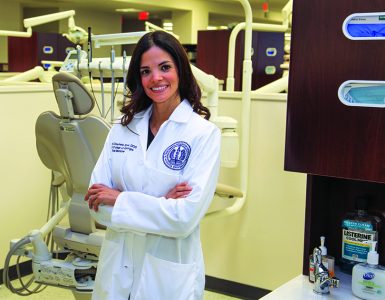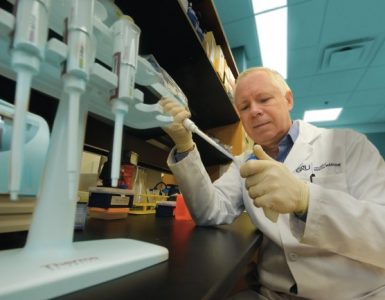Class Project Received Funding for Cancer Patients’ Oral Health
When Zach Dubin lost an aunt to oral cancer recently, his consolation was knowing that in a few years, he would be able to help others battling the disease.
What he didn’t know is that he wouldn’t have to wait a few years.
Jumping at the Opportunity
Dubin, a second-year student in The Dental College of Georgia, had an assignment last year that kicked his aspirations into high gear, even before he finished school. Dr. Kate Ciarrocca, assistant professor in the Department of Oral Health and Diagnostic Sciences, tasks first-year students in her Community Oral Health Promotion course with writing a mock grant proposal to improve access to oral health care. “Students are assigned to groups of four to write a fictitious grant application for up to $25,000,” said Ciarrocca.
The students are grouped randomly, so their interests might vary widely. But Ciarrocca noted that Dubin’s group – which included Varun Iyer, Dahlia Levine and Diana Tran – gelled instantly, inspired largely by the recent loss in Dubin’s family.
[su_note note_color=”#efefee” text_color=”#000000″ class=”story-side-box”]About the Dental Trade Alliance Foundation
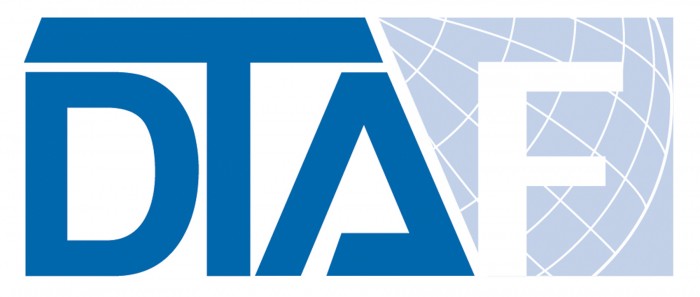 The Dental Trade Alliance Foundation seeks to broaden oral health care awareness for those in need. With a focus on oral health, access to care and the connection of oral health to overall health, the foundation funds innovative pilot projects designed to broaden awareness of and access to oral health care in America. Seventy-one projects have received a total of $1.5 million in funding since the foundation’s first grants were awarded in 2002.[/su_note]
The Dental Trade Alliance Foundation seeks to broaden oral health care awareness for those in need. With a focus on oral health, access to care and the connection of oral health to overall health, the foundation funds innovative pilot projects designed to broaden awareness of and access to oral health care in America. Seventy-one projects have received a total of $1.5 million in funding since the foundation’s first grants were awarded in 2002.[/su_note]
“I had moved in with my aunt the year before dental school to help her through her treatment, and I was with her every step of the way,” Dubin said. “The side effects she experienced before she died – inflammation, fungal infections, pain – were still fresh in my mind when we were assigned the project. I jumped at the opportunity to help people going through that.”
Said Ciarrocca, “All of the projects were great – they covered fluoride treatment, sealants and other aspects of dentistry – but this was the only one that tackled oral cancer.”
Noted Iyer, “We had recently learned how mucositis and other oral side effects affect cancer patients. As a result, many are unable to eat properly or take their medication due to the severe oral pain. And patients are often unaware of the importance of getting dental treatment prior to chemotherapy, which can result in rampant tooth decay. We realized these patients could strongly benefit from opening a line of communication between dentists and oncologists.”
Pulling at Heartstrings
Ciarrocca’s clinical practice at the DCG is limited to treating cancer patients, so she was thrilled to see this budding interest in the classroom.
“I solely treat cancer patients, and I have a 19-year-old niece whose leukemia is in remission, so cancer treatment is both a personal and professional passion of mine,” she said. “As soon as the students chose this topic, it pulled at my heartstrings.”
And she was impressed with their proposal, which sought to better educate general dentists and the public about oral health ramifications of cancer. “It’s so important from a professional standpoint,” Ciarrocca said. “Cancer patients often don’t understand why they’re referred to a dentist; they’ll say, ‘I already have a dentist.’ But treating cancer patients is very different than treating healthy ones.”
The cancer itself, as well as treatments such as radiation, can compromise oral health, she noted (See ‘A Huge Step,’ page 24), and oral problems can become systemic, jeopardizing overall health.
“As an oral medicine specialist, what I do is largely the oral management of medical-related disorders of the maxillofacial region,” she said. Although general dentists can manage some of these problems themselves, she cited the importance of their knowing what to look for, how to head off potential problems and when to refer patients to specialists.
[su_note note_color=”#efefee” text_color=”#000000″ class=”story-side-box”]’A Huge Step’
Oral complications are the norm, not the exception, for patients undergoing cancer treatment, regardless of the type of cancer.
Consider:
• 40 percent of patients undergoing primary chemotherapy report oral side effects.
• 80 percent of those undergoing myeloablative conditioning regimens for hematopoietic stem cell transplantation report oral effects.
• 100 percent of patients undergoing radiation therapy for head and neck cancer experience oral issues.
“Acute oral toxicities to cancer therapies can at times be reduced, yet they are essentially unavoidable,” said Dr. Kate Ciarrocca, DCG assistant professor in the Department of Oral Health and Diagnostic Sciences.
Cancer patients undergoing treatment have an increased risk of multiple oral health issues, including xerostomia, mucositis, rampant decay, trismus and osteoradionecrosis. “These issues severely affect quality of life for cancer patients both during treatment and after,” Ciarrocca said. “Oral discomfort can lead to decreased medication adherence, interruption in cancer treatment and reduced caloric intake, all of which decrease long-term prognosis.”
She noted that cancer treatment until recently was hospital-based, enabling oral health specialists to treat patients there. But today’s trend toward outpatient treatment for most components of cancer treatment means that “most patients rely on their own private dentist to manage oral ramifications,” Ciarrocca said, “and often, the professionals have limited knowledge in treating these issues.
“The students’ grant is a huge step in better integrating oral health treatment into cancer care,” she said.[/su_note]
Serendipitous Circumstances
The students’ proposal would greatly advance these objectives, she said, while also helping laypeople understand the oral health component of cancer treatment.
In the most serendipitous of circumstances, she was delighted to recently discover that the Dental Trade Alliance Foundation wholeheartedly agrees.
The foundation coincidentally issued a call for proposals soon after Dubin and his classmates completed their project. Almost on a lark, Ciarrocca asked the students if they’d be interested in submitting the pretend grant for real-world funding. Their answer was a resounding yes. But they had to work quickly to meet the submission deadline.
“The students were on break at the time, so we were emailing each other back and forth,” Ciarrocca recalled. “The deadline for proposals was May 27 at midnight, and I submitted ours at 10 p.m. that night.”
What might strike others as stressful struck them as exhilarating. “It was so much fun,” she said.
And even more so when they received word that out of 100 nationwide submissions, the students’ grant would be one of eight funded by the foundation.
[su_pullquote align=”left”]“When we realized our project would generate a more widespread impact, we were overtaken with joy.” –Diana Tran (’18)[/su_pullquote]
‘We’ve Got This!’
“The most fun part was telling the students,” Ciarrocca said. “They were in class, so I pulled them out and told them. I wish I’d videotaped it. We jumped around in a big circle like 2-year-olds.”
Recalled Levine, “I saw her running into our classroom and I thought, ‘Oh, we’ve got this!’”
“We were ecstatic to say the least,” Iyer said. “We had never expected that a class project would end up being the recipient of a nationally recognized organization and could potentially benefit and improve the lives of cancer patients.”
Added Dubin, “It was so surprising. It took a full week just to process it.”
Next comes the hard work of implementing their vision. The grant will fund lunch-and-learn sessions and other means of educating dentists and the public about oral health for cancer patients. “We believe the key to long-term positive change in patient care begins with education,” Ciarrocca said. “Patients will gain the knowledge necessary to act as their own advocates, and dentists will have access to resources essential to achieving first-rate treatment outcomes.”
She added that since community service is required of DCG students, the project should fold seamlessly into their schedules.
Said Ciarrocca, “They can’t wait to get started.”
“It wouldn’t have happened without Dr. Ciarrocca. She’s just awesome. She never forgets to put the focus on the patient,” said Levine, who relates to classmate Dubin’s personal investment in the grant: She has a family member battling jaw cancer.
Said Dubin, “Now, we have an opportunity to help people going through what our loved ones have gone through.”

